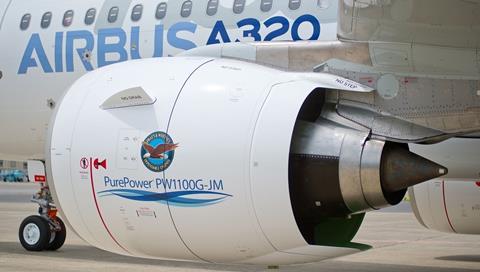The Federal Aviation Administration intends to require airlines replace a rotor in Pratt & Whitney PW1100G geared turbofans after a 2022 rotor failure caused an in-flight engine shutdown.
The 8 July 2022 shutdown resulted from a fractured first-stage integrally bladed rotor – also called a blisk – in the low-pressure compressor of an Airbus A320neo’s PW1100G, the FAA says in a proposed rule made public on 22 March.

The filing, which provides no further detail about the failure, would require airlines replace those rotors and make other changes to 215 PW1100Gs on US-registered jets – the entire US fleet of A320neo-family aircraft with the engines.
News of the issue comes as P&W and the FAA grapple with a separate powder-metal manufacturing problem effecting PW1100Gs. That issue has significantly upended airlines’ operations, forcing carriers globally to ground hundreds of jets at any given time.
“The [proposal] relates to a known issue that affected a limited number of engines and is unrelated to powder metal,” P&W says. “The improved hardware has been deploying to the fleet over the past two years through previously released service bulletins.”
The July 2022 incident resulted from a “misaligned” inlet guide vane sitting “directly upstream” of the first-stage integrally bladed rotor in the engines’ low-pressure compressor. Resulting “aerodynamic excitement” caused the rotor to fail, the FAA says.
P&W has already developed a fix. It redesigned the inlet guide vane “arm assembly by adding a spacer to provide additional torque capability and to prevent a misaligned vane”, the FAA says.
The Connecticut engine maker also redesigned the PW1100G’ s first-stage integrally bladed rotor “to better withstand an aerodynamic excitement from a misaligned” guide vane.
The FAA proposal would require airlines to implement the fixes. They would need to install new washers and spaces during the first subsequent shop visit, and replace first-stage integrally bladed rotors during the first maintenance event that involves removing the rotor.


























